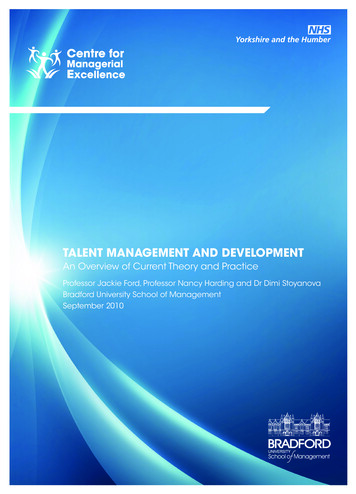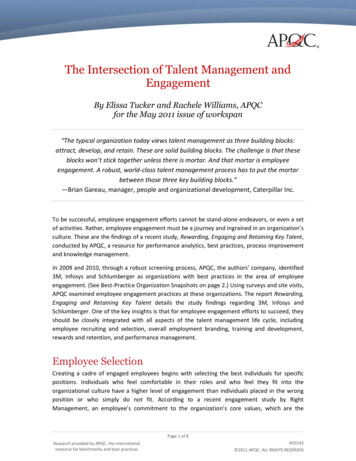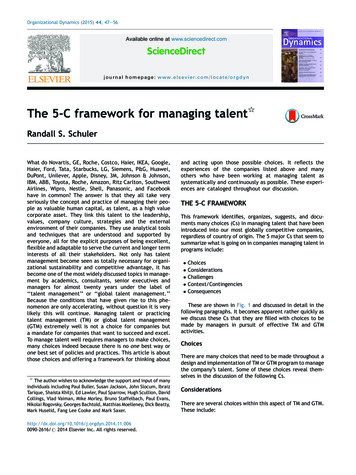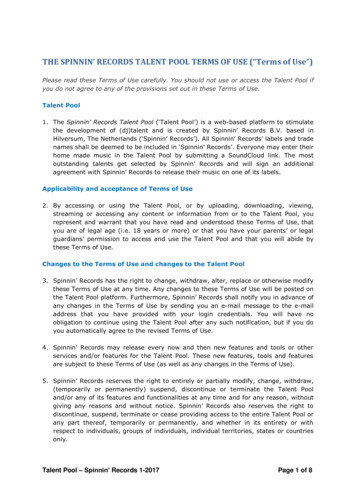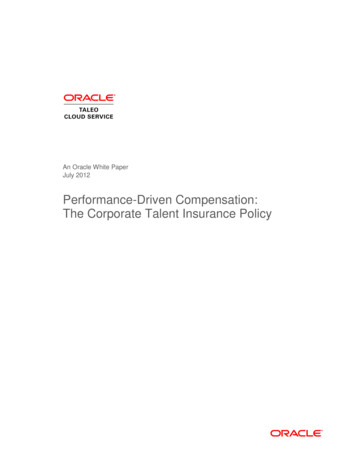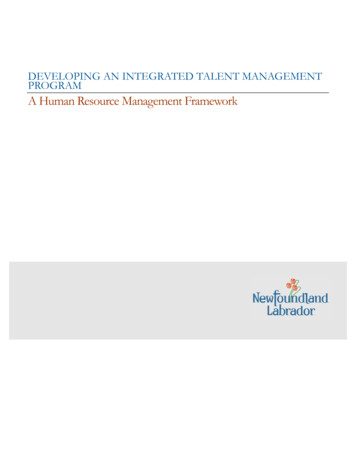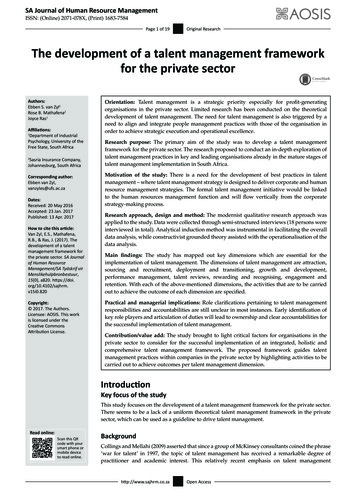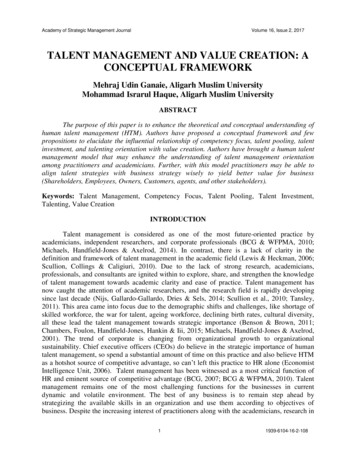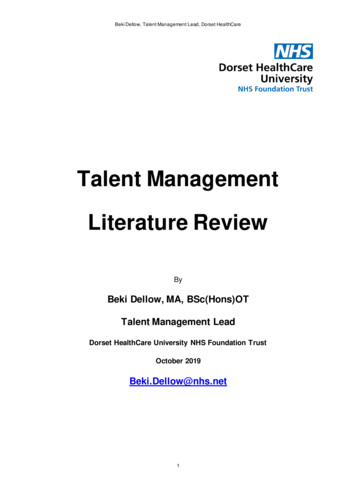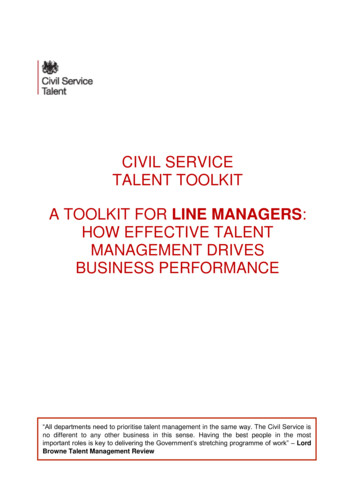
Transcription
CIVIL SERVICETALENT TOOLKITA TOOLKIT FOR LINE MANAGERS:HOW EFFECTIVE TALENTMANAGEMENT DRIVESBUSINESS PERFORMANCE“All departments need to prioritise talent management in the same way. The Civil Service isno different to any other business in this sense. Having the best people in the mostimportant roles is key to delivering the Government’s stretching programme of work” – LordBrowne Talent Management Review
Table of ContentsHow to use this toolkit3Who is talent for?3What does talent mean?3What is talent management?4Why do talent management?4Talent management across the Civil Service5Talent management in practice6Step 1 – Get to know your people7Step 2 – Identify your key people needs8Step 3 – Identify your high potential people10Step 4 – Plan to address the issues11Step 5 – Take action13Step 6 – Review progress14Some final thoughts15Annex A – Career Conversation Framework and Tips17Annex B – Assessing the criticality of your business roles19Annex C – Summary of Civil Service Indicators of Potential21Annex D – The nine-box talent grid23Annex D (a) – The nine-box talent grid – suggested development24interventionsAnnex E – Succession planning template25Annex F – Talent Manager checklist26Annex G – Talent Management Roles and Responsibilities28Relevant Civil Service Learning resources30A Civil Service Toolkit For Line Managers2
How to use this toolkitTalent management is a critical part of a line manager’s role; when delivered well it canhelp drive performance and improve business outcomes. This toolkit aims to supportline managers to become skilled and effective at developing their talented people.Whilst the toolkit is primarily targeted towards managers at Grade 7/Band A and above,the talent management principles will apply to all levels.The toolkit provides guidance for thinking though talent management. It signpostsadditional resources and support; including a range of tools in the annex. Using thesetools will provide a consistent and good practice approach across the Civil Service.The nine-box talent grid, which is referenced later in the toolkit, is a useful tool to helpidentify talent by assessing (current) performance and (future) potential. Whilst notmandatory for grades below Grade 7, the grid can be a helpful resource for all talentmanagers.If you manage people who manage others, ensure they also understand that talentmanagement is an important part of their role.Who is talent for?Talent management is for everyone in order to identify talent appropriately. It isimportant that line managers regularly include all their staff in discussions about theirdevelopment, aspirations and performance. This will support the right people into theright roles, provide access to the right opportunities, exposure, stretch and developmentto reach their potential.What does talent mean?Identifying and developing talent is a top priority for the Civil Service and yourcontribution to this agenda will be supporting the Civil Service Talent Strategy.Talented individuals demonstrate the highest potential to go furthest and fastest withinthe organisation than their peers. For the purposes of this guide, this means peoplewho have the potential to perform at SCS as set out in the SCS Indicators of Potentialand demonstrate behaviours set out in the Civil Service Leadership Statement.The corporate talent schemes managed by Civil Service Talent, supports thedevelopment of talent at Grade 7/Band A and above to move into and through the SCS.Many departments also run their own local development or talent schemes for theirtalented individuals below Grade 7. In addition, there are centrally run talentprogrammes such as the Civil Service Fast Stream, Fast Track Apprenticeship Scheme,the Professions and Diversity Schemes.A Civil Service Toolkit For Line Managers3
What is talent management?Talent management is the approach by which we source, nurture and deploy thoseindividuals who demonstrate the potential to progress faster and further than their peergroup. Every employee wants to feel supported in developing their career in whicheverdirection they choose and to have an honest conversation about their prospects. Talentmanagement builds on that by identifying those who demonstrate the most potential anddeveloping them to meet their individual aspirations, the needs of the team, and theneeds of the organisation.Why do talent management?“Good talent management leads to greater efficiency. It delivers a diverse and inclusiveorganisation in which the best people thrive, whoever they are. It is a key leadershipissue and a critical part of any senior role” Lord Browne Talent Management Review.We need to develop world-class leaders for the future of the Civil Service so we areready for tomorrow’s challenges as well as todays.Identifying business critical roles and potential successors for these roles is an integralpart of senior managers’ and leaders’ jobs. They must ensure that potential successorsget the necessary breadth of experience and this needs to begin far enough in advanceto ensure there is sufficient time to develop those who have potential but not yet theright experience. Further information on succession planning can be found in the HR &Professions Talent Toolkit.The Civil Service is committed to delivering the best possible public service. A keyenabler in achieving this is building an inclusive organisation with diverse teams thatreflect the society in which we serve. That principle runs through our approach to talentmanagement.Managing talent well offers several benefits: Delivering more effectively – Ensuring your team is best placed to meet yourbusiness needs both now and in the future. It will help you achieve your businessgoals, and avoid gaps in capability and therefore impact on business delivery. Engaged employees contribute more - Engaged staff are potentially able toperform 20% better and high potential employees have been shown to contribute20% more discretionary effort than their peers. Think of the difference thatcontribution could make to performance levels and the customer experience. Attracting talent - Talented employees need the organisation less than theorganisation needs them. They want more in return including recognition,commitment to their development; and stretch. Managers have a corporateresponsibility to develop talent within the Civil Service; this includes encouraging andsupporting talent to move outside their team to help individuals acquire a greaterA Civil Service Toolkit For Line Managers4
breadth of experience. High potential employees will want to come and work forthose managers who manage their talent well and will help them to develop further. Creating a wider, more diverse pool of people –Access to a wider pool of peoplewithin teams, departments and increasingly across the Civil Service to addressbusiness needs. It gives managers more options. Personal satisfaction – Supporting your team to fulfil their career aspirations is oneof the most rewarding aspects of being a manager. It is also something that we valueand look for in high performing managers.Talent management across the Civil ServiceThe Civil Service Talent Strategy for the Civil Service High Potential Stream focuses onthe identification and development of those with the most potential to reach the mostsenior levels of the Civil Service. You can find this and other resources on the CivilService Learning talent webpages and OneHR website.The Reform Plan highlighted a stronger role for professions in people development andtalent management. Professions are focussing on improving their talent profile acrossgovernment in their specialism and are working towards developing to support strongtalent management. This will help with the deployment of talent and expertise acrossgovernment and ensure those with the highest potential fill the most challenging roles.Effective talent management helps retain the Civil Service’s best people. Since theFuture Leaders Scheme and Senior Leaders Scheme launched, less than 1% ofparticipants has left the Civil Service. The turnover rate for individuals on the HighPotential Development Scheme (HPDS 2007 - 2013) is 4.5%, compared to 13.7% forthe wider Director population. HPDS participants are also half as likely to resigncompared to the wider Director population (1.8% compared to 3.9%).A Civil Service Toolkit For Line Managers5
Talent management in practiceTalent management is about behaviours as much as a series of processes. The bestmanagers build it into the way they work and are continually taking action to make ithappen. There are six steps below to get you started. Once you are familiar with thesethen you will find it easier to build this kind of activity into your daily life as a manager.Much of the time this will be local action, other times you will engage with the widerorganisation.1. Get to know your people – Knowing your people means knowing what eachindividual in your team wants from their career and working with them to help themachieve their aspirations and potential.2. Identify your key people needs – You have to be clear on what you are developingtalent for. What are the key roles you need to plan for and fill? What are the mostpressing capability gaps getting in the way of your team’s delivery?3. Identify your high potential people – Who are the people in your team with themost potential to go further and faster?4. Plan to address the issues – What are the gaps between what you need to deliverand the people you have in your team? What will you do to bridge any gaps andmake sure you get the outcomes you need?5. Take action – What are the next actions to deliver your plan?A Civil Service Toolkit For Line Managers6
6. Review progress – Have your actions achieved what was needed or do you need todo more or tackle differently? Has the context around you changed? Are yourbusiness needs still the same both short and long term?Step 1 – Get to know your peopleWhy is this important?Every employee should feel that their line manager and the organisation takes aninterest in their career and will help support their aspirations. It helps individuals to getthe best out of themselves and organisations to get the best out of its people.What do I need to do? Familiarise yourself with how careers are developing in the Civil Service withinyour field e.g. key career paths; Civil Service professions; key skills, andcompetences. Check Civil Service Learning and talk to your line manager.Talk to each of your team on a regular basis about: what they want from their career what steps they are planning to achieve that whether their next direction might be a promotion; a level move; or to deepentheir expertise in their current role your current view of their potential fit with those aspirationsKey areas to reflect on How well do I understand how careers are developing in the Civil Service? Whatmore could I do to build that understanding? How frequently do I have career conversations with my team members? How clear are each of my team members about their careers and the steps they planto get there? How can I help them? How can I support them to develop their career? What’s my current view of their potential against their career aspirations? Is their planrealistic? Where do they need to demonstrate more or differently? How am I going totalk about that in a constructive way?A Civil Service Toolkit For Line Managers7
Key points Your team members are responsible for driving their own careers. It is theirresponsibility to plan for and take appropriate action. You can guide them by askingthe right questions or signposting possible next steps. An informal conversation can be more meaningful for an individual than a formalreview of their development plan. It’s perfectly OK for people to be happy where they are in their careers. Noteverybody wants to move up the organisation but you still need to support them withtheir development. Don’t make assumptions about people’s aspirations as they may change. Be honest with people, managing their expectations. Prepare well for thisconversation (see annex A). Encourage your team members to think bigger picture e.g. networking effectively,marketing themselves and gaining visibility.Resources and support to help Annex A has a framework for a career conversation. Review Achieving Your Potential, a career planning guide on Civil Service Learning.There are numerous other resources to help individuals and managers e.g. LineManager’s Guide to Building Capability. Several professions have published on Civil Service Learning useful information tohelp with career paths, career planning and key professional competences.Step 2 – Identify your key people needsWhy is this important?Developing your people with a clear alignment to what you need to achieve in your teamwill have the most impact on performance. It will help them understand what they areaiming for and what they might need to incorporate into their development plans.What do I need to do? Understand the context you’re working in, your team’s business goals, currentchallenge, and how the future may look different.Understand the particular people challenges you face or will face e.g. evolvingor hard-to-fill roles; new skills needed; lack of diversity; lack of an obvious successorfor key roles in the team, and where your team has strengths.Identify your most critical business roles (see annex B)A Civil Service Toolkit For Line Managers8
Key areas to reflect on What are the key business challenges you will face in the future? How can you startto prepare your people for short and long term challenges? How do your teamsaspirations fit with your business plans now and in the future? What are the capability gaps getting in the way of your team’s delivery? What are the business critical roles you need to fill now or in the future? What is thelikelihood and impact of people leaving those roles in the next 12 months? Do you have robust succession plans for your key roles? Do you need to think beyond your immediate team?Key points There is a considerable overlap here with workforce planning. Talent management isa subset which focuses more on individual people and roles. Depending on your role you may want to work through this individually, with your linemanager, management team, Head of Profession, HR Business Partner or CohortLeader (for Fast Streamers). Every role in your team will make an important contribution. But there will be a fewroles where not having the right person would have a much greater impact on teamperformance. This isn’t always about seniority of the role; some expert roles may becrucial to your business. Some roles may be critical to your business but there may be a steady supply ofpeople with the skills and experience to do them. Focus on the harder to fill roles. It is likely that your organisation will produce a list of business critical roles regularlyto support talent strategy and succession planning at that level. The work you do willhelp feed into this. Remember to link up with wider departmental successionplanning. To ensure transparency, every individual, department and line manager of thatindividual should be aware if they feature on a succession plan and should agreetheir potential for the role.Resources and support to help Annex B has a model to help you identify the criticality of your roles. Civil Service Learning has numerous resources to help you think through your team’schallenges.A Civil Service Toolkit For Line Managers9
Step 3 – Identify your high potential peopleWhy is this important?Everybody has potential. It might be to grow in their current role or to do a slightly biggerrole at the same career level. Line managers should support people to develop thatpotential.Line managers have a corporate responsibility to identify, develop and retain highpotentials within the Civil Service. You will want to maximise their performance whilstthey are in your team. High potentials will have career options and the drive to go andachieve them. If you don’t offer them recognition; job satisfaction; wider involvement;stretch and development, they may start to look elsewhere.What do I need to do? Review the potential of each member of your team in terms of their aspiration,ability, engagement and values (see annex C).Assess where you think they are on the nine-box talent grid (see annex D) drawingon the Civil Service Indicators of Potential; their performance track record; and thegrid descriptions. Reviewing the grid regularly is good practice as this ensures youhave the most up-to-date picture of your talent pool.Participate in any wider talent review discussions which will help ensure consistencyof assessment and identify possible opportunities and actions beyond yourimmediate team. These may happen at team, business area, organisational,profession, or Civil Service level.Ensure transparency, the final potential assessment needs to be discussed witheach team member at an appropriate time. This works better if it blends into yourregular career discussions.Key areas to reflect on What does each of your team have the potential to do more of or be better at? How strong is the evidence for each of your team against the Civil Service Indicatorsof Potential and Leadership Statement? Where do you think each team member is on the nine-box talent grid? What is yourevidence to support that assessment? Who are the high potential individuals in your team who demonstrate the strongestaspiration, ability, engagement and leadership values?A Civil Service Toolkit For Line Managers10
Key points You should complete the Civil Service Learning Unconscious Bias e-learning beforeparticipating in talent review discussions. High potential people demonstrate the aspiration, ability, engagement, and theleadership values to move up the organisation further and faster than their peers. Inthe Civil Service, this group is made up of those assessed as Star Performer, HighPotential or Early Promise. Consideration should also be given to those who sit inStrong Performer. You may also be interested in the people who help you answer one of the key riskareas you identified at Step 2 e.g. a specialist with scarce skills who may not gohigher but who you want to retain and identify successors for. Assessment of Potential is a snapshot in time. They need to be reviewed regularlyand new evidence considered. People’s circumstances and aspirations change. Overtime you will build a fuller picture of their potential. People may move in and out ofhigh potential status. High performance or high professional expertise do not necessarily equal highpotential. People can achieve successful outcomes with a variety of styles and approaches,and diversity should be championed.Resources and support to help Annexes C and D set out the Civil Service Indicators of Potential and the nine-boxtalent grid.Step 4 – Plan to address the issuesWhy is this important?Now you have an understanding of what you need to deliver and the people you have inyour team, what do you need to do to bridge any gaps and make sure you get theoutcomes you need?What do I need to do? Prioritise the areas of highest risk by comparing your analysis of what you need(Step 2) with the supply of people you identified at Step 3.Plan for succession into your most critical roles (see Annex E). Who could doshort-term emergency cover? Who have you got in the pipeline to do the role in thefuture? How ready are they? Will it be soon enough? Do you want or need to take aBuild, Borrow or Buy approach (see below)?Plan development with your high potentials. Understand their aspirations andcareer goals. Talk through with them the kind of roles you could see them movinginto – how far and fast they could go. Ensure they have a robust career anddevelopment plan.A Civil Service Toolkit For Line Managers11
Key areas to reflect on What are your biggest risk areas? What skills do you need to start building now tomeet future need? Where would you be most exposed if the person left? What does your succession planning tell you? Where have you got strength in depth?What critical roles have you not got enough successors for? Are you over-reliant on 1or 2 people? How can you mitigate your succession risks? What can you do now to help potentialsuccessors develop and be better prepared for the role? Can you borrow successorsfrom other teams, the wider organisation or profession? Can you buy in thenecessary skills? How clear are your high potential people on their career goals? What kind of roles doyou think they could do? How far and fast could they go? Do they have potential forthe Civil Service High Potential Stream? How robust are their career anddevelopment plans?Key points Take into account any organisational or relevant professional talent strategies. Focus on the highest risk issues with the greatest impact on your team’sperformance. Deciding your approach to succession planning will depend on the role, your potentialsuccessors, organisational context, and the job market amongst other things. Youcan build your pipeline of people by proactively working on their development. Youcan borrow to supplement your pipeline with potential successors in other businessareas, organisations, the wider profession, or other sectors. You can buy theexpertise needed through external recruitment or interim arrangements. Yourapproach may combine these options. For most roles you will want to try and build the internal pipeline so that the CivilService can grow more of its own expertise. Sometimes you may choose to borrow. Ifyou borrow to supplement a skills gap, think about how you use this resource to helpgrow your internal skills and capability in this area. You may choose to buy in skills tobring in and develop new thinking. Succession planning is about ensuring that you have a competent and competitivepool of people to fill the gaps as they arise and does not mean people will not need tocompete for roles.Resources and support to help There’s a succession planning template at Annex E.A Civil Service Toolkit For Line Managers12
Step 5 – Take actionWhy is this important?Taking action will bring your plans to life and give you momentum. It will help you meetthe expectations you’ve raised with your people. And ensure effective business delivery.What do I need to do? Action your succession management plan. Whether you are building, borrowing,or buying, you now need to take action.Support your high potential people to develop. That could encompass a wholerange of actions depending on the individual. Here are some suggested actions formanagers of high potentials:o What opportunities are available for their development in your organisation, theirprofession, and across the Civil Service (see Civil Service Learning talentwebpages).o Spot and signpost stretch opportunities for them in your business area, and morewidely.o Ensure they get the most out of stretch opportunities discussing objectivesbeforehand and reflecting afterwards.o Increase their visibility across the organisation.o Challenge and support them to action their career and development plan.Key areas to reflect on What are the next actions to take to strengthen your succession planning andmitigate any risks? What will you do to build the pipeline? What are the next actions to support your highpotentials to develop? If you are borrowing, who will you talk to? Have you flagged to them that you arelooking to borrow? How will you bring them in? How will you use their skills andknowledge to grow internal capability? If you are buying, how will you engage and approach the market to get the best field?How will you bring them in? If a specialist role, are you talking with your Head ofProfession?Key points Plan and act well ahead of when your need will arise. It can take time for people tobuild the experience needed. You may need to invest some time in identifying andengaging target audiences if you are borrowing or buying. Moves between teams orA Civil Service Toolkit For Line Managers13
organisations generally work better if they can be planned with say 6 months noticeto allow for everybody to plan accordingly. It is important that you take action to test any assumptions in your successionplanning. Talk to your Head of Profession to see what the supply of people is likerather than assume it will meet your needs. Research or talk to your resourcing teamabout the job market for particular roles. Developing high potential people is not a passive activity. The individual shouldalways be in the driving seat with you as the talent manager offering support andchallenge. Don’t hold back your high potentials by holding on to them too long. You will need tolet them go for the good of their development; the organisation; and the Civil Service.You will be rewarded in time by high potential people returning back to you.Resources and support to help Your departmental talent team, resourcing team, or local profession contacts. Civil Service Learning talent webpages. Civil Service professions may be able to provide development suggestions or helphigh potentials make cross-Government contacts.Step 6 – Review progressWhy is this important?You will want to check back that your actions have achieved what you intended. Equallythings change quickly and events may overtake your planning and actions. So you willwant to review your progress and plans on a regular basis.What do I need to do? Review whether your actions are moving you towards the outcomes youwanted.Review whether your plans and actions need updating in the light of newevents or information.Key questions to answer Where have you made good progress? What’s your evidence? How can you build onthat progress? Where has progress been slower? How can you address that? Do you need to domore or tackle differently? How do your plans and actions need updating in the light of changes around you?Has the future vision changed? What changes have there been in your team andorganisation? Have work priorities changed? Are the same roles still critical?A Civil Service Toolkit For Line Managers14
Have individuals’ circumstances and aspirations changed? Have your high potentialpeople made the kind of progress you would have expected? What action do youneed to take if not? Are you confident you are reaching and identifying talent from under-representedgroups? If not, do you need to take further positive action to embed a more inclusiveapproach?Key points You should aim to review your whole approach and succession plan at least sixmonthly. You may choose to have more focussed discussions about particularlytricky areas in-between e.g. a key specialist post or group of posts.Resources and support to help You may want to find someone from outside your business area to act as a criticalfriend to help you sharpen your plan.Some final thoughtsYou will soon become familiar with the actions in this toolkit. There’s a checklist atAnnex F as a quick reminder. Annex G summarises the responsibilities of differentplayers in talent management for reference.The next step will be to live the behaviours of a skilled and effective talent manager: Are you constantly on the lookout for those with potential, not just in your own teambut across the organisation? Do you help them to gain visibility? Are you offering your support to help people grow? Do you help people achieve theirfull potential and career goals? Do you mentor people outside your team? Do youthink about how opportunities within your team could be valuable to upcoming talentelsewhere as well as your own people? How proactive are you in building truly diverse teams and then getting the most out ofthat diversity? How far would others see you as a role model for identifying and developing talent?What could you do to step that up further? Are you being corporate about sharingtalent? How much do you act as a ‘magnet’ for talent? Do talented people want to work withyou because they know you will help them develop? What do you do to engage and connect high potential people both internally andexternally with your organisation and with the Civil Service more broadly?A Civil Service Toolkit For Line Managers15
How strong will the team be that you leave behind you when you move on?Of course all of this takes time so you will need to be ready to invest the effort to reapthe rewards. As a guide managers and leaders in the best practice talent managementorganisations spend about half a day a week on this kind of activity.A Civil Service Toolkit For Line Managers16
AnnexesAnnex A – Career Conversation Framework and TipsCareer development research conducted by the Institute for Employment Studiessuggests there are five outcomes that individuals are looking for:1. Understanding ‘what is out there for someone like me?’ and possible paths.Increasingly this is less about complex career frameworks and more about gaininginsights into what particular roles are like.2. Someone to ‘sit down and talk to’ – usually a range of ‘someones’ who can offerdifferent perspectives to supplement the conversations with their line manager e.g.peers, mentor, senior sponsor, family/friends, head of profession or similar3. Confidence in skills and knowledge to make effective career decisions e.g.support to think through and agree a plan4. Support to make an ‘unusual’ move e.g. broaden experience in a differentprofession or organisation – how you go about it and support to make it happen5. Understanding perceived potential relative to other people i.e. do my aspirationsand potential align?Good quality career conversations can help individuals clarify their career goals andbuild a plan to achieve them. Conversations should be honest even where this might bechallenging e.g. where what an individual and what the business wants don’t align.Eff
Talent management is a critical part of a line manager's role; when delivered well it can help drive performance and improve business outcomes. This toolkit aims to support line managers to become skilled and effective at developing their talented people. Whilst the toolkit is primarily targeted towards managers at Grade 7/Band A and above, .

